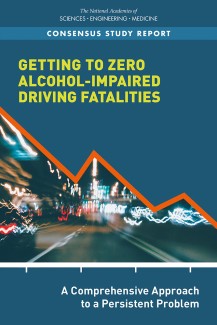Getting to Zero Alcohol-Impaired Driving Fatalities: A Comprehensive Approach to a Persistent Problem

Alcohol-impaired driving remains the deadliest and costliest danger on U.S. roads today. Every day in the United States, 29 people die in an alcohol-impaired driving crash—one death every 49 minutes. After decades of progress, alcohol-impaired driving fatality rates plateaued and have increased for the past two years—making it a persistent public health and safety problem. Each alcohol-impaired driving crash represents a failure of the system. A coordinated, systematic, multi-level approach spanning multiple sectors is needed to accelerate change.
With support from the National Highway Traffic Safety Administration, the National Academies of Sciences, Engineering, and Medicine convened a committee to help identify promising strategies to reduce deaths caused by alcohol-impaired driving in the United States. The resulting report, Getting to Zero Alcohol-Impaired Driving Fatalities: A Comprehensive Approach to a Persistent Problem, highlights interventions and actions to reduce alcohol-impaired driving fatalities— including ways to improve important existing interventions—and presents ideas for reviving public and policymaker attention, thereby turning concern into decisive action to address this tragic and preventable problem.
